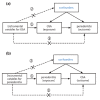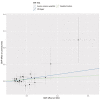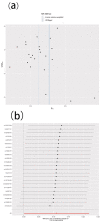Genetically predicted obstructive sleep apnea is causally associated with an increased risk for periodontitis
- PMID: 37803323
- PMCID: PMC10559524
- DOI: 10.1186/s12903-023-03338-8
Genetically predicted obstructive sleep apnea is causally associated with an increased risk for periodontitis
Abstract
Background: Although obstructive sleep apnea (OSA) and periodontitis are associated, whether this association is causative is uncertain.
Methods: We conducted a bidirectional Mendelian randomization (MR) analysis using data from publically accessible genome-wide association studies. The single-nucleotide polymorphisms (SNPs) for OSA were derived from 16,761 cases and 201,194 controls. The pooled data of periodontitis association involved up to 17,353 individuals. Disease-associated single-nucleotide polymorphisms were selected as an instrumental variable at the genome-wide significance level (p < 5.0 × 10- 6). Subsequently, the causal effects were estimated using three different methods: inverse variance weighting (IVW), MR-Egger, and weighted median. Then, these causal estimates were expressed as dominance ratios [odds ratio (OR)].
Results: The MR analysis revealed that genetically determined OSA promotes the development of periodontitis [ IVW OR = 1.117, 95% confidence interval (CI) = 1.001-1.246, p = 0.048). Furthermore, no causal effect of genetically predicted periodontitis on OSA was noted in the reverse MR analysis (IVW OR = 1, 95% CI: 0.95-1.06, p = 0.87). The trend in results from the MR-Egger regression and weighted median (WM) was consistent with that in results from the IVW method. The robustness of the results was confirmed by the sensitivity analysis.
Conclusions: In summary, the results of our MR investigation suggest an association between OSA and periodontitis, proposing that early screening and treatment of OSA is beneficial for the prevention and prognosis of periodontitis.
Keywords: Causality; Mendelian randomization; Obstructive sleep apnea; Periodontitis.
© 2023. BioMed Central Ltd., part of Springer Nature.
Conflict of interest statement
All authors have declared that no conflicts of interest exist.
Figures



Similar articles
-
The Causal Relationship Between Opioid Use and Obstructive Sleep Apnea: A Bidirectional Mendelian Randomization Study.Pain Physician. 2025 Mar;28(2):E147-E156. Pain Physician. 2025. PMID: 40168564
-
Causal associations between obstructive sleep apnea and COVID-19: A bidirectional Mendelian randomization study.Sleep Med. 2023 Jan;101:28-35. doi: 10.1016/j.sleep.2022.09.013. Epub 2022 Oct 13. Sleep Med. 2023. PMID: 36334498 Free PMC article.
-
Correlation between obstructive sleep apnea and cerebral small vessel disease: a mendelian randomization study.Genes Genomics. 2023 Sep;45(9):1179-1186. doi: 10.1007/s13258-023-01402-9. Epub 2023 Jun 10. Genes Genomics. 2023. PMID: 37300787
-
Association of short sleep with risk of periodontal disease: A meta-analysis and Mendelian randomization study.J Clin Periodontol. 2021 Aug;48(8):1076-1084. doi: 10.1111/jcpe.13483. Epub 2021 Jun 9. J Clin Periodontol. 2021. PMID: 34109656 Review.
-
[Research progress of Mendelian randomization analysis in obstructive sleep apnea].Zhonghua Er Bi Yan Hou Tou Jing Wai Ke Za Zhi. 2024 Jul 7;59(7):774-781. doi: 10.3760/cma.j.cn115330-20240210-00086. Zhonghua Er Bi Yan Hou Tou Jing Wai Ke Za Zhi. 2024. PMID: 39107130 Review. Chinese.
Cited by
-
Causal associations between sleep traits and temporomandibular disorders: a bidirectional mendelian randomization analysis.Front Genet. 2024 Jul 24;15:1429190. doi: 10.3389/fgene.2024.1429190. eCollection 2024. Front Genet. 2024. PMID: 39113681 Free PMC article.
-
Albiflorin Inhibits Advanced Glycation End Products-Induced ROS and MMP-1 Expression in Gingival Fibroblasts.Curr Stem Cell Res Ther. 2025;20(4):434-440. doi: 10.2174/011574888X302174240420165019. Curr Stem Cell Res Ther. 2025. PMID: 38685787
References
-
- Chapple ILC, Mealey BL, Van Dyke TE, Bartold PM, Dommisch H, Eickholz P, et al. Periodontal health and gingival diseases and conditions on an intact and a reduced periodontium: Consensus report of workgroup 1 of the 2017 World workshop on the classification of Periodontal and Peri-Implant Diseases and Conditions. J Periodontol. 2018;89(Suppl 1):74–s84. - PubMed
-
- Armitage GC. Development of a classification system for periodontal diseases and conditions. Annals of Periodontology. 1999;4(1):1–6. - PubMed
-
- Shaddox LM, Morford LA, Nibali L. Periodontal health and disease: the contribution of genetics. Periodontol 2000. 2021;85(1):161–81. - PubMed
-
- Genco RJ, Borgnakke WS. Diabetes as a potential risk for periodontitis: association studies. Periodontol 2000. 2020;83(1):40–5. - PubMed
-
- Kocher T, König J, Borgnakke WS, Pink C, Meisel P. Periodontal complications of hyperglycemia/diabetes mellitus: epidemiologic complexity and clinical challenge. Periodontol 2000. 2018;78(1):59–97. - PubMed
Publication types
MeSH terms
LinkOut - more resources
Full Text Sources

